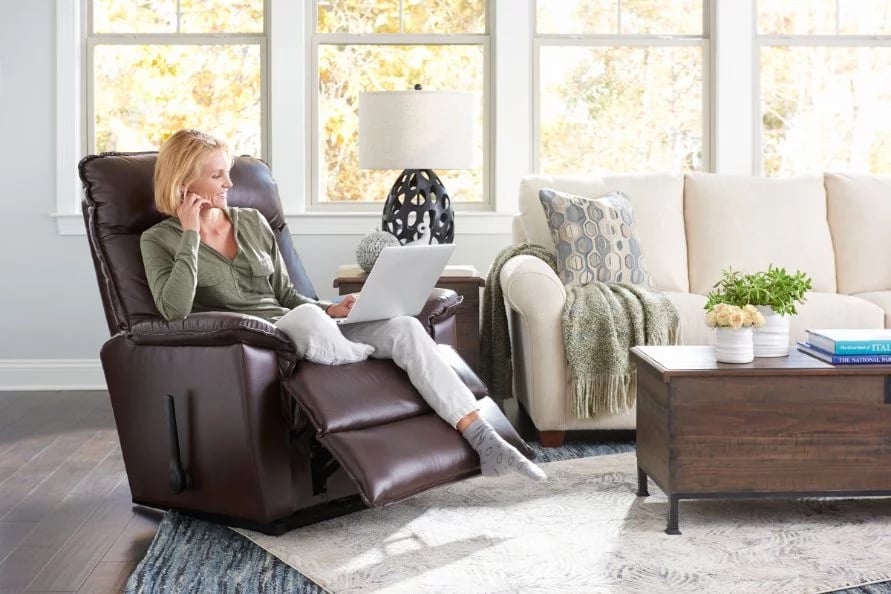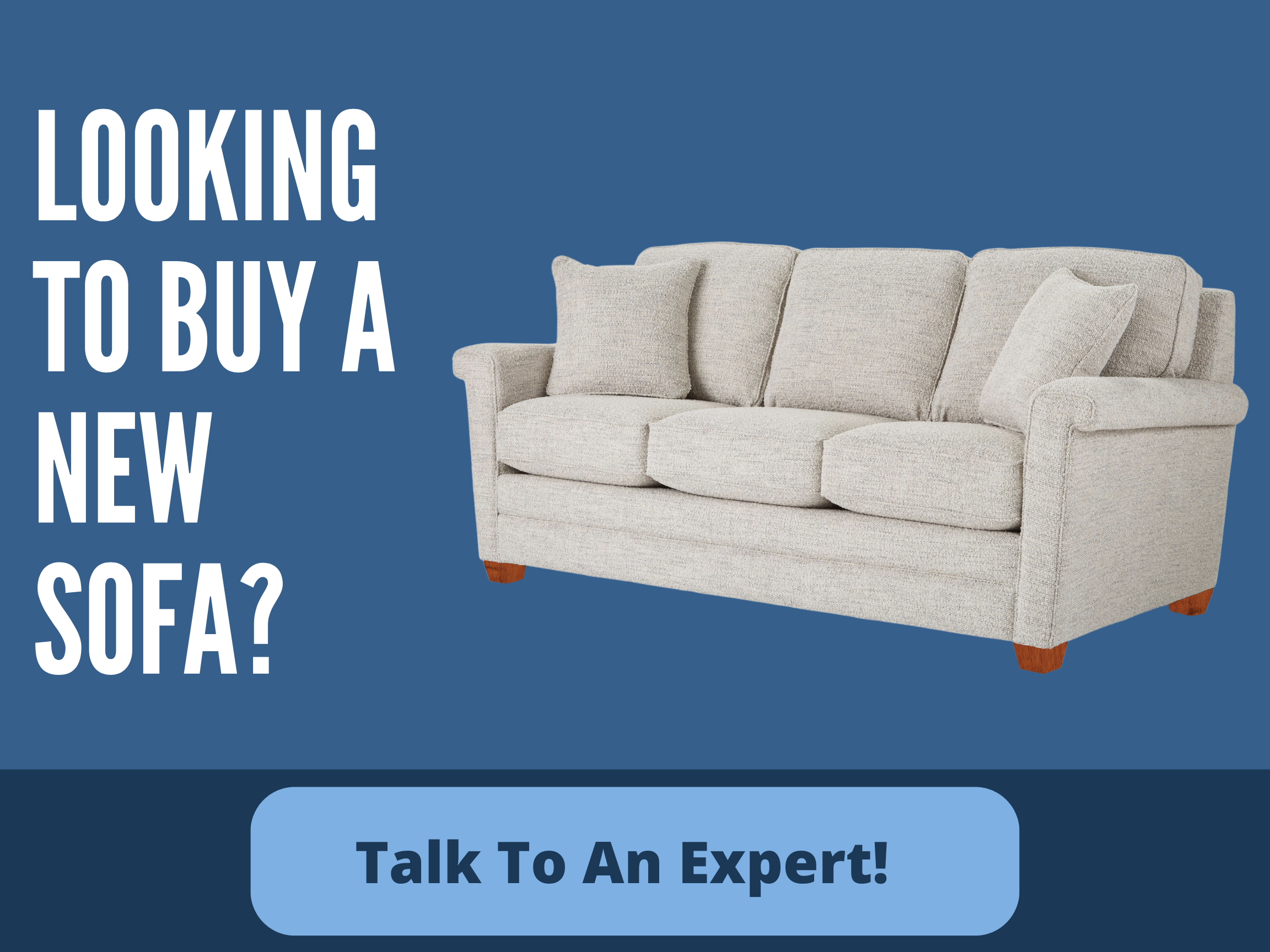Fabric vs. Leather: Which Is Better for Your Living Room Furniture?
March 10, 2025

Est. Reading Time: 7 Mins
When shopping for a new sofa or chair, one of the biggest decisions you’ll face is choosing between fabric or leather upholstery. Your selection will impact not only the look and feel of your furniture but also its durability, maintenance, and cost. Since this is a long-term investment, making the right choice is crucial for your home and lifestyle.
Mary Lee Smyth, the interior designer at La-Z-Boy Kingston, she says La-Z-Boy Ottawa, Gatineau & Kingston offers an extensive collection of over 800 fabric and leather options to help you find the perfect fit. This article will provide a comprehensive comparison between fabric and leather furniture, helping you make an informed decision based on comfort, durability, maintenance, cost, and sustainability.
Key Takeaways
- Fabric and leather upholstery each offer unique benefits, depending on your needs and lifestyle.
- Fabric provides a wide variety of colours, patterns, and textures, while leather is known for its timeless appeal and natural patina.
- Leather tends to be more durable and easier to clean, whereas fabric is often softer and more customizable.
- Cost varies widely in both categories, with premium leathers being more expensive, while designer fabrics can also come at a high price point.
- Both fabric and leather can be sustainable choices, depending on how they are sourced and manufactured.
- La-Z-Boy offers custom upholstery options with high-quality fabric and leather selections in Ottawa, Gatineau and Kingston.
In This Article…
- How Comfortable is Fabric Compared to Leather?
- How Does Appearance Compare with Fabric and Leather?
- How Durable is Fabric Compared to Leather?
- Which Upholstery is Easier to Clean?
- How Expensive is Fabric Compared to Leather?
- How Sustainable is Fabric Compared to Leather?
- Fabric vs Leather: Comparison Breakdown
- Can You Mix Fabric and Leather Furniture?
Fabric vs. Leather: A Side-by-Side Comparison
How Comfortable is Fabric Compared to Leather?
Fabric:
Mary Lee says, Fabric upholstery is known for its softness and breathability, making it a great option for those who want a cozy and inviting feel. "Natural fibres such as cotton and linen provide breathability, while synthetic fabrics like microfiber or polyester add durability and stain resistance."
Leather:
Mary Lee also says, Leather has a luxurious feel that adapts to body temperature, staying cool in the summer and warm in the winter. "Over time, full-grain leather moulds to your body, enhancing its comfort. Some may find leather firmer initially, but it becomes more supple with use."
How Does Fabric Appear Compared to Leather?
Fabric:
With thousands of colour, pattern, and texture options, fabric allows for extensive customization. Whether you prefer bold statement pieces or neutral classics, fabric provides flexibility to match your personal style.
Leather:
Leather offers a timeless and sophisticated look that ages beautifully. It develops a rich patina over time, enhancing its character. While leather colours are more limited than fabric, protected leather finishes provide more variety.
How Durable is Fabric Compared to Leather?
Fabric:
Durability varies based on material and weave. Microfiber and tightly woven synthetic fabrics are highly resistant to wear and stains, making them ideal for homes with pets or children. Natural fibres like cotton and linen, while soft, may show wear faster.
If you’re interested in seeing which Fabric is Most Durable, take a look at this article.

Leather:
Leather is naturally strong and resistant to tears, spills, and dust. Top-grain leather has excellent durability, while aniline leather is more delicate and can scratch easily. Leather is also resistant to pet hair and odours, making it a great option for allergy sufferers.

What Upholstery is Easier to Clean?
Fabric:
Fabric requires more regular cleaning to prevent dust and stains from setting in. However, performance fabrics such as La-Z-Boy’s iClean™ technology provide superior stain resistance, making maintenance easier.
Leather:
Leather is relatively low-maintenance, as spills can be wiped away with a damp cloth. However, aniline leather requires conditioning to prevent drying and cracking, while protected leather is more resistant to stains and scratches.
How Expensive is Fabric Compared to Leather?
Fabric:
Fabric is generally more affordable than leather, though high-end designer fabrics or performance materials can increase the price.
Leather:
Leather is typically more expensive, especially top-grain and full-grain leather. However, bonded leather or faux leather options provide a more budget-friendly alternative.
How Sustainable is Fabric Compared to Leather?
Fabric:
Synthetic fabrics are made from non-renewable resources, but natural fibres like organic cotton and wool offer eco-friendly alternatives. La-Z-Boy’s Conserve™ Sustainable Fabrics, made from recycled water bottles, provide an environmentally friendly choice.
Leather:
Leather is a natural material, and many hides come from by-products of the meat industry, preventing waste. However, Mary Lee notes that chemical tanning processes can have environmental impacts, though vegetable-tanned leather offers a more sustainable option.

Summary Table: Fabric vs. Leather
|
Category |
Fabric |
Leather |
|
Comfort |
Soft and breathable; varies by fibre type |
Molds to body over time; initially firm but softens with use |
|
Appearance |
Unlimited colour and pattern options |
Develops a rich patina; timeless look |
|
Durability |
Synthetic fabrics resist stains; natural fibres may wear faster |
Strong, tear-resistant, and repels dust and pet hair |
|
Maintenance |
Requires regular cleaning; stain-resistant fabrics available |
Easy to clean; requires occasional conditioning |
|
Cost |
Typically lower cost; designer fabrics can be expensive |
Higher upfront cost; bonded leather offers budget-friendly options |
|
Sustainability |
Options include organic cotton and recycled fabrics |
Naturally biodegradable; sustainable tanning methods available |
Can You Mix Fabric and Leather Furniture?
Yes! Mixing fabric and leather furniture is a great way to add contrast, texture, and visual interest to your living space. A leather sofa pairs well with fabric accent chairs, while a fabric sectional can be complemented by leather ottomans or side chairs. "To create a cohesive look, balance colours and textures, since smooth leather works well with textured fabric, and neutral leather tones can complement bold fabric patterns," says Mary Lee.
Accessories, like throw pillows, rugs, and blankets, can help tie the materials together. By thoughtfully mixing fabric and leather, you can achieve a stylish, inviting, and functional space that suits your lifestyle.
To learn more about Mix and Matching Fabric and Leather, take a look at this article.

What's Next?
The information you’ve learned in this article will help you figure out which upholstery is the best fit for you. With this newfound information, what is holding you back from getting new furniture? Time to start shopping!
Visit us at one of our local Ottawa, Gatineau or Kingston showrooms or plan by scheduling a visit. One of our sales consultants will be happy to help you get fitted for a recliner of your choice.
If you’re interested in learning more about La-Z-Boy’s fabric or leather selection, take a look at our Fabric Upholstery Guide or our Leather Covers Guide.
Related Links
Problems with Leather Furniture
(1).jpg?width=150&height=150&name=9C8A3062-Enhanced-NR%20(1)(1).jpg)
Nicholas Carchidi
Content Writer at StyleMeetsComfort.ca
Nick has been the lead content writer for La-Z-Boy Ottawa, Gatineau and Kingston since 2022, specializing in the furniture industry. He collaborates with experts in his field, ensuring that each piece on the La-Z-Boy Learning Centre is accurate and valuable. He provides readers with expert knowledge on all things furniture. If you'd like to learn more about Nick, you can check out his LinkedIn page here.
Product Info Request
Please provide us with your name and email and we'll get back to you as soon as possible regarding this item.

